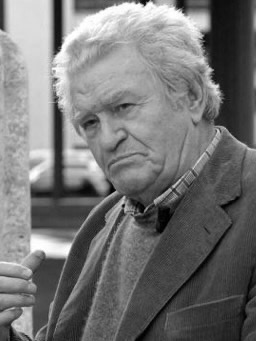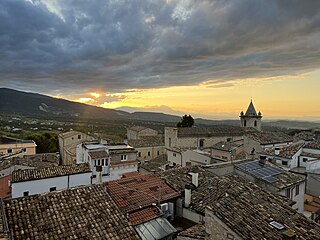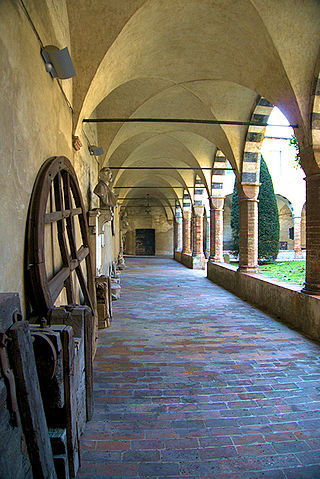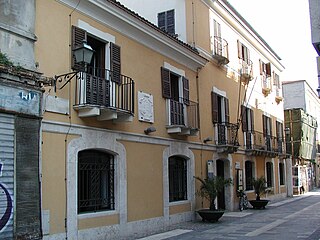
Abruzzo, historically known as Abruzzi, is a region of Southern Italy with an area of 10,763 square km and a population of 1.3 million. It is divided into four provinces: L'Aquila, Teramo, Pescara, and Chieti. Its western border lies 80 km (50 mi) east of Rome. Abruzzo borders the region of Marche to the north, Lazio to the west and north-west, Molise to the south and the Adriatic Sea to the east. Geographically, Abruzzo is divided into a mountainous area in the west, which includes the highest massifs of the Apennines, such as the Gran Sasso d'Italia and the Maiella, and a coastal area in the east with beaches on the Adriatic Sea.

Pietro Cascella was an Italian sculptor. His principal work consisted of large monumental sculptures, including the International Monument to the Victims of Fascism in the Auschwitz II-Birkenau death camp in Poland (1957–1967), and an underground mausoleum for Silvio Berlusconi at his villa in Arcore in the 1980s.

Pescara is the capital city of the province of Pescara, in the Abruzzo region of Italy. It is the most populated city in Abruzzo, with 118,657 residents. Located on the Adriatic coast at the mouth of the River Aterno-Pescara, the present-day municipality was formed in 1927 joining the municipalities of the old Pescara fortress, the part of the city to the south of the river, and Castellamare Adriatico, the part of the city to the north of the river. The surrounding area was formed into the province of Pescara.

The province of Chieti is a province in the Abruzzo region of Italy. Its provincial capital is the city Chieti, which has a population of 50,770 inhabitants. The province has a total population of 387,649 inhabitants as of 2017 and spans an area of 2,599.58 square kilometres (1,003.70 sq mi). The province contains 104 comuni. Its provincial president is Mario Pupillo.

The province of Pescara is a province in the Abruzzo region of Italy. Its capital is the city of Pescara, which has a population of 119,483 inhabitants. As of 2017, it has a total population of 319,936 inhabitants over an area of 1,230.33 square kilometres (475.03 sq mi). The provincial president is Antonio Zaffiri and the province contains 46 comuni.

Chieti is a city and comune (municipality) in Southern Italy, 200 kilometres east of Rome. It is the capital of the province of Chieti, in the Abruzzo region.

Guardiagrele is a town and comune in the province of Chieti, part of the Abruzzo region of central Italy. It is in the foothills of the Maiella mountain at an elevation of around 576 metres (1,890 ft). Its population numbers about 10,000.

Abruzzo Airport is an international airport serving Pescara, Italy. It is located approximately 4 kilometres (2.5 mi) from the centre of Pescara, about 180 km (110 mi) from Rome, a 2-hour drive by car on a motorway across the Apennine Mountains. The airport is located on the state road 5 Via Tiburtina Valeria and is well connected to important roads and railway connections.
Giuseppe Tontodonati was an Italian poet.

Michele Cascella was an Italian artist. Primarily known for his oil paintings and watercolours, he also worked in ceramics, lithography, and textiles. He exhibited regularly at the Venice Biennale from 1924 until 1942, and his works are owned by major museums in Italy and Europe, including Victoria and Albert Museum in London, Galerie nationale du Jeu de Paume in Paris, and Galleria Nazionale d'Arte Moderna in Rome.

Tourism in Abruzzo has become one of the most prosperous sectors in the economy of Abruzzo, and in recent years has seen a remarkable growth attracting numerous tourists from Italy and Europe. According to statistics, in 2021 arrivals totaled 1,330,887. A total of 5,197,765 arrivals were tourists, a figure that puts the region seventeenth among the Italian regions for numbers of tourists per year. A moderate support to tourism is also given to the Abruzzo Airport with many low cost and charter flights connecting the entire region with the rest of Europe.

The Civic Museum of Crema is an Italian museum located in Crema.

Castello di Roccascalegna is a medieval castle in Roccascalegna, Province of Chieti, Abruzzo, southern Italy.

Museo delle genti d'Abruzzo is an ethnographic Museum in Pescara, Abruzzo.

Museo Civico di Teramo is an art museum in Teramo, Abruzzo.

Museo d'Arte Moderna Vittoria Colonna is a modern art museum in Pescara, Abruzzo.

The Gabriele d'Annunzio Birthplace Museum is located at 116 Corso Manthoné in Pescara and was declared a national monument in 1927. Since December 2014, the Ministry of Cultural Heritage and Activities has managed it through the Polo Museale dell'Abruzzo, which became the Regional Directorate of Museums in December 2019.
Tommaso Cascella senior (1890–1968) was an Italian painter, known for brightly colored landscapes.

Basilio Cascella was an Italian artist, active from the late nineteenth century to the mid-twentieth century.

Silvio Formichetti is an Italian painter. His work mainly comprises abstract and informal paintings and drawings.





















